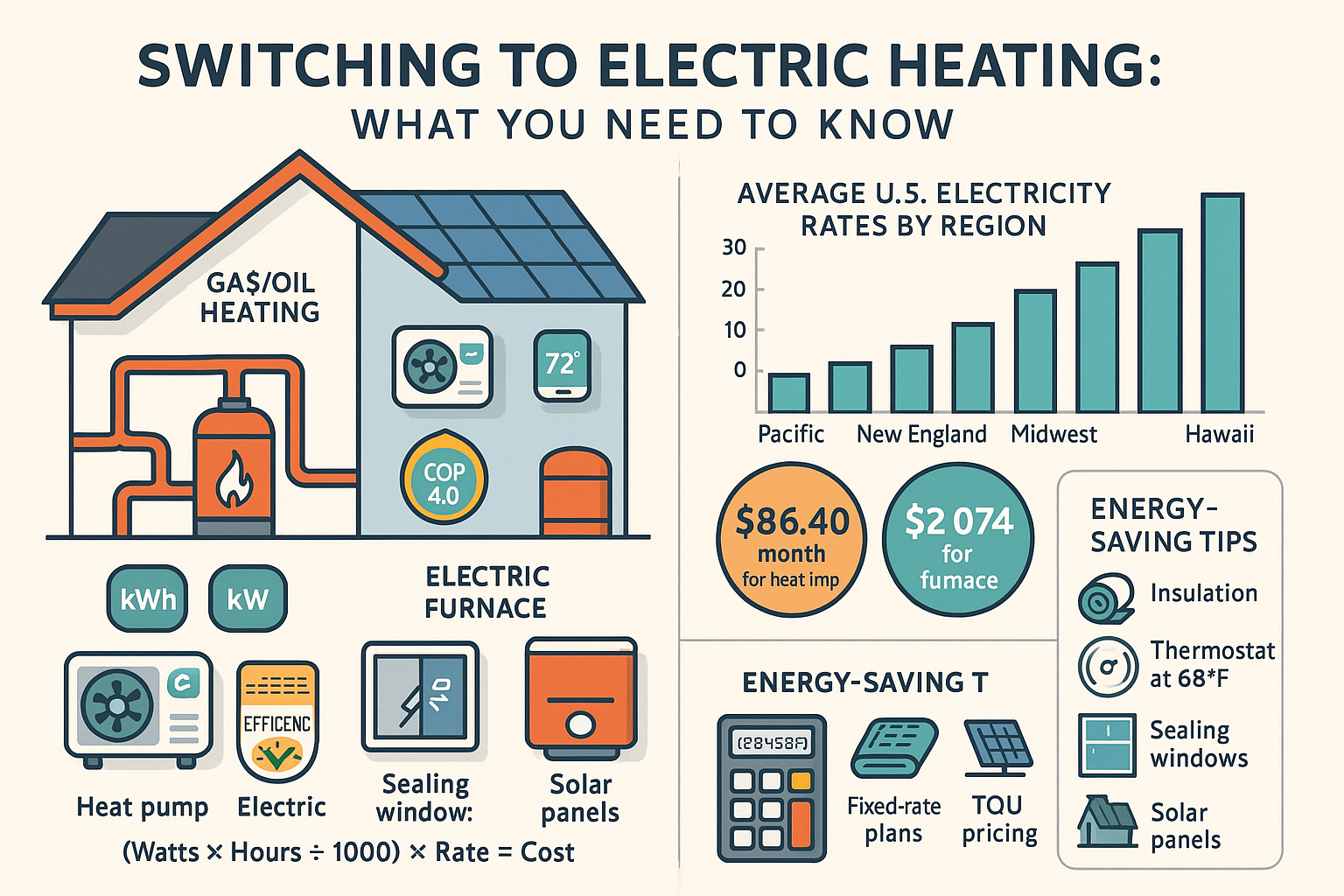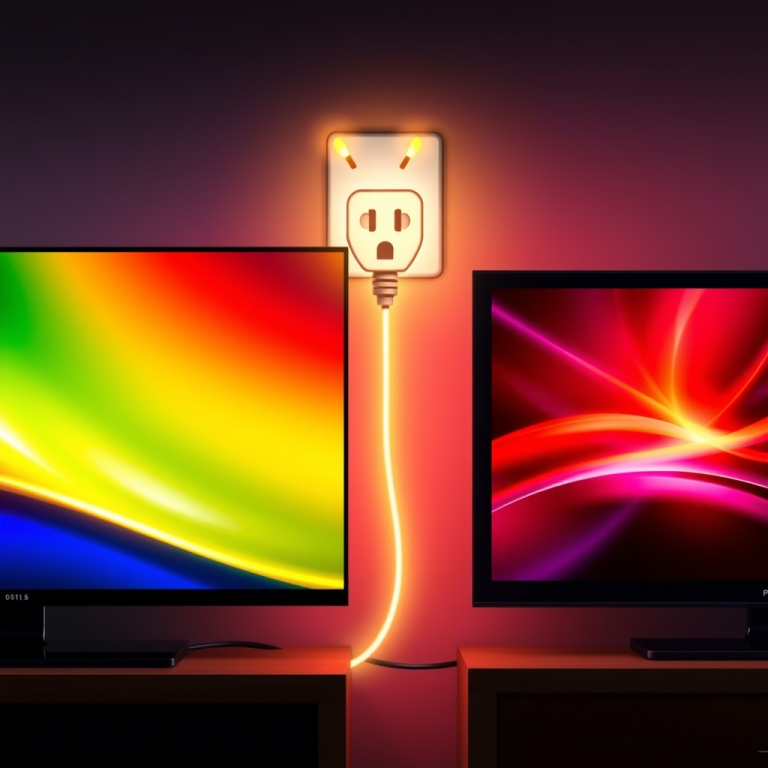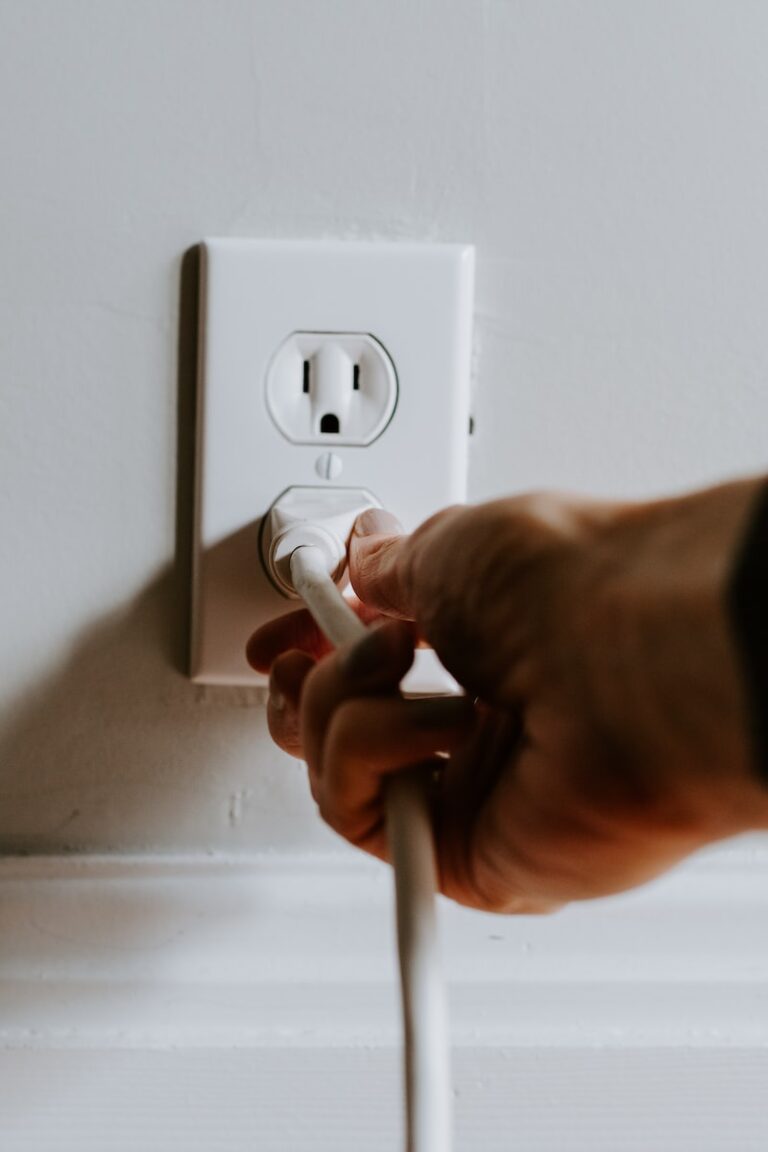How to Calculate Your Energy Bill When Switching to Electric Heating
Switching from gas or oil heating to electric heating can be a big change for your home. With electricity prices rising across the U.S.—now averaging $0.16 per kilowatt-hour (kWh) and expected to go up another 13% by 2025—it’s more important than ever to understand how this switch will affect your energy bills.
This guide breaks down everything you need to know to estimate your future heating costs, including:
- How electric bills are structured
- The efficiency of different types of electric heaters
- How to calculate your usage and cost
- Ways to save money and use electricity smarter
Section 1: Understanding How Electricity Bills Work
1.1 What’s in an Electricity Bill?
Your monthly bill is made up of several parts:
- Energy Charge: This is what you pay for the actual electricity you use. It’s calculated by multiplying the number of kilowatt-hours (kWh) you used by the price per kWh.
- Example: If you used 1,000 kWh, and your rate is $0.16/kWh, that part of your bill would be $160.
- Makes up 40–60% of most bills.
- Delivery Charges: These cover the cost of getting electricity to your home (transmission and distribution). They make up about 40% of your bill.
- Includes a fixed monthly fee (like $5–$10) and a per-kWh delivery charge (e.g., $0.04/kWh).
- Time-of-Use (TOU) Pricing: Some utilities charge more during busy times (like weekday afternoons). Rates can be 2–3 times higher during these peak hours.
1.2 Key Terms You Need to Know
- kW (Kilowatt): A measure of power at one moment. Like how fast water flows through a pipe.
- kWh (Kilowatt-hour): A measure of total energy used over time. Like how much water went through the pipe in an hour.
- Example: A 1,500W space heater running for 2 hours uses 3 kWh.
- COP (Coefficient of Performance): How efficient a heat pump is. For example, a COP of 3 means it produces 3 times more heat than the electricity it uses.
- HSPF (Heating Seasonal Performance Factor): A rating for how well a heat pump works over an entire season.
Table: Average Electricity Prices Across the U.S. (2025)
| Region | Avg. Price per kWh | Why It’s Expensive |
|---|---|---|
| Pacific Coast (CA, WA, OR) | ~21¢ or more | Wildfires, regulations |
| New England (MA, NY, CT) | ~20¢ or more | Natural gas shortages |
| West North Central (MN, ND, SD) | ~11¢ | More coal, less demand |
| Hawaii | 41¢ | Far from fuel sources |
Section 2: Which Electric Heating System Is Right for You?
There are three main types of electric heating systems. Each has different costs and efficiencies.
2.1 Heat Pumps – Most Efficient Option
Heat pumps move heat from the air or ground into your home. They’re much more efficient than old electric furnaces.
- How to Calculate Monthly Use:
(Watts × Hours per day × Days used) ÷ 1,000 = kWh/month
Example:3,000W × 6 hours/day × 30 days = 540 kWh/month - Efficiency Changes with Temperature:
- At 47°F, COP = 4.0 → very efficient
- At 17°F, COP = 2.2 → half as efficient
So, efficiency drops by 45% when it gets colder. - Monthly Cost Example:
540 kWh × $0.16 = $86.40
Compare that to $220+ for an electric furnace!
2.2 Electric Furnaces – High Power, High Cost
These are older systems that generate heat directly using electric coils.
- Typical Power Use: 10,000 to 50,000 watts
Example: A 18,000W system for a 2,400 sq ft house18,000W × 4 hrs/day × 180 days/year = 12,960 kWh/season
Cost:12,960 × $0.16 = $2,074 per winter
2.3 Space Heaters – Great for Small Spaces
Portable heaters work best for warming just one room instead of your whole house.
| Wattage | Hourly Cost ($0.16/kWh) | Monthly Cost (4 hrs/day) |
|---|---|---|
| 1,500W | $0.24 | $28.80 |
| 3,000W | $0.48 | $57.60 |
Tip: Use a space heater in the room you’re in and keep other doors closed to save energy.
Section 3: How to Accurately Calculate Your Costs
3.1 Step-by-Step Manual Calculation
Here’s how to figure out how much each appliance will cost:
- Find the wattage on the label or calculate it:
Amps × Volts = Watts
(Example: 12A × 120V = 1,440W) - Track daily use (how many hours per day it runs)
- Calculate daily kWh:
(Watts × Hours) ÷ 1,000 = Daily kWh - Multiply by 30 for monthly use
- Multiply by your rate per kWh to get the cost
Example:
- Heater: 1,500W × 4 hours = 6,000 Wh = 6 kWh/day
- Monthly: 6 × 30 = 180 kWh/month
- Cost: 180 × $0.16 = $28.80/month
3.2 Special Rate Structures
Some utilities charge more based on how much you use or when you use it.
Tiered Rates
You might pay more once you pass a certain usage level.
Example:
- First 300 kWh at $0.18/kWh
- Anything above that at $0.27/kWh
If your heat pump adds 500 kWh/month:
(300 × $0.18) + (200 × $0.27) = $54 + $54 = $108/month
Time-of-Use (TOU) Pricing
Electricity costs more during busy times.
Example:
- Peak hours (3 PM – 8 PM): $0.32/kWh
- Off-peak (nights/weekends): $0.10/kWh
Using your heater during off-peak hours can cut your costs in half or more!
3.3 Tools That Help
- Whole-Home Energy Monitors: Show exactly how much each appliance uses (costs around $200–$500).
- Utility Bill Calculators: Many utility companies have online tools to help compare plans and rates.
Section 4: Comparing Electric vs. Gas or Oil Heating
4.1 How Much Would Electricity Need to Cost to Be Cheaper Than Gas?
You can compare gas prices to electric ones using this formula:
(Gas price per unit ÷ kWh equivalent) × 1,000 = Break-even electricity rate
Example:
- Natural gas price: $1.20 per therm
- 1 therm = 29.3 kWh
(1.20 ÷ 29.3) × 1,000 = $41.00/kWh- So if electricity is cheaper than $0.041/kWh, it beats gas
But remember—heat pumps are more than 200% efficient, so they often beat gas even at higher rates.
4.2 Heat Pump vs. Gas Furnace in Cold Climates
| Feature | Gas Furnace | Heat Pump |
|---|---|---|
| Efficiency | Always 80% | Varies (150–250%) |
| Fuel Cost (NY) | $15.84/Mcf | $0.22/kWh |
| Annual Cost (2,400 sq ft) | $1,150 | $1,620 |
| Winner | Gas | N/A |
Even though gas seems cheaper, heat pumps are getting better every year—and they also cool your home in summer!
Section 5: Strategies to Lower Your Heating Bill
5.1 Choose the Right Equipment
- Heat Pumps Save Money: Can cut heating costs by 40–60% compared to old electric furnaces.
- ENERGY STAR Models: Up to 15% more efficient than regular models.
- Right Size Matters: Too big or too small and it won’t work efficiently.
5.2 Smart Ways to Use Your Heater
- Set Thermostat to 68°F in Winter – Saves 10% annually.
- Run During Off-Peak Hours – Shift heating to nights or weekends.
- Use Thermal Mass – Store heat in bricks or water tanks during cheap hours.
5.3 Improve Your Home’s Efficiency
- Insulate the Attic: Cuts heating costs by 25% (EPA estimate).
- Seal Windows and Doors: Saves 10–20% on heating.
- Add Solar Panels: Reduces high-cost usage. Get a 30% tax credit from the government.
Section 6: Managing Rising Electricity Costs
6.1 Lock in Fixed Rates
If your state lets you choose your electricity provider:
- Fixed-rate plans let you lock in today’s prices for 1–3 years.
- Avoid variable rates that jump with market changes.
6.2 Community Solar Programs
No roof space for solar panels?
- Join a community solar farm and get 5–10% off your bill without installing anything.
6.3 Payback Periods for Heat Pumps
Let’s say you spend $8,000 on a new heat pump and save $1,400 per year compared to an electric furnace:
- Payback Time: $8,000 ÷ $1,400 = 5.7 years
- After that, you’ll save $1,400/year for 15+ years = $21,000+ savings
Final Thoughts: Make the Switch Smarter
Switching to electric heating doesn’t have to mean higher bills. By understanding:
- Your local electricity rates
- The efficiency of your heating system
- How you use electricity throughout the day
…you can reduce your costs by 30–50% or more.
Pro Tip: Ask your HVAC contractor for a Manual J load calculation to size your system right. And try the Lumina Heat Pump Calculator to see how much your bill might change.
With smart planning, electric heating can be both affordable and eco-friendly—especially as the grid gets cleaner every year.




